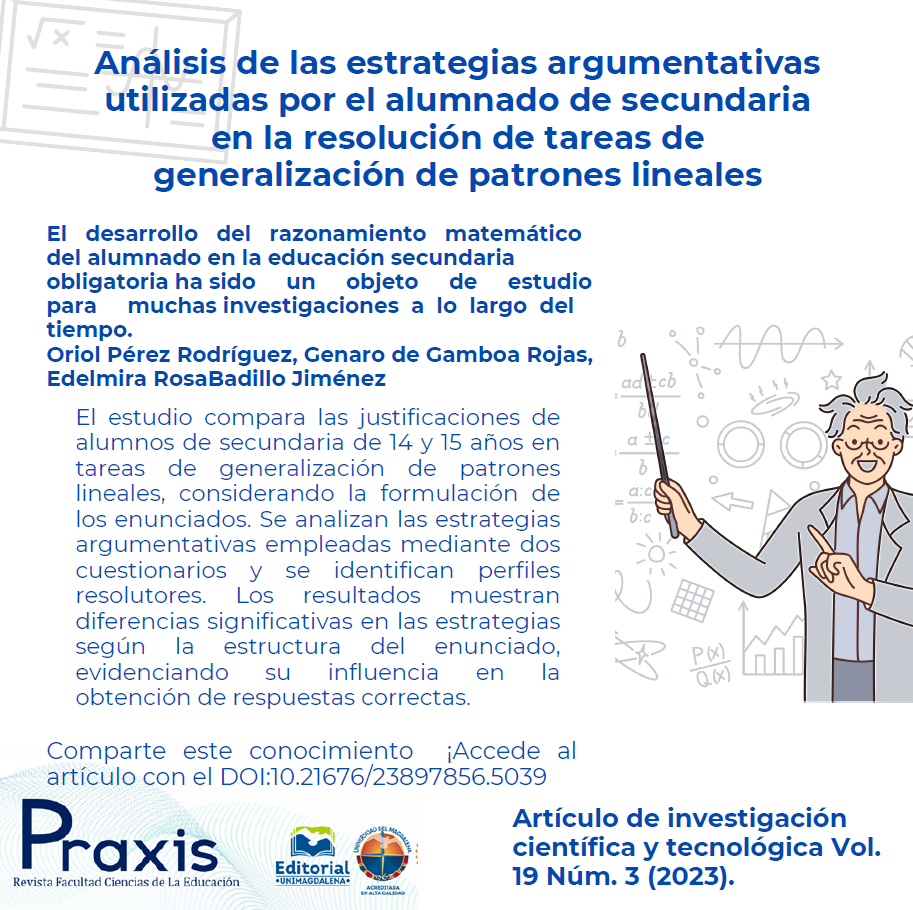Análisis de las estrategias argumentativas utilizadas por el alumnado de secundaria en la resolución de tareas de generalización de patrones lineales
Contenido principal del artículo
Resumen
El trabajo tiene como objetivo comparar las justificaciones que genera el alumnado de secundaria de 14 y 15 años en tareas de generalización de patrones lineales, relacionándolas con la manera de formular los enunciados. En el estudio se analizaron las estrategias argumentativas utilizadas por los alumnos cuando la estructura del enunciado varía utilizando dos cuestionarios; para ello, se analizaron las justificaciones escritas a las tareas en los cuestionarios y se identificaron perfiles resolutores de todo el alumnado para cada tarea en base a las estrategias argumentativas utilizadas. A continuación se comparan estos perfiles resolutores para cada alumno en los dos cuestionarios propuestos. Los resultados muestran que una parte del alumnado presenta diferencias significativas en las estrategias argumentativas que utilizan para resolver los dos cuestionarios. Se puede concluir que hay casos donde la estructura del enunciado es determinante para llegar a una respuesta correcta.
Descargas
Detalles del artículo

Esta obra está bajo una licencia internacional Creative Commons Atribución-NoComercial-CompartirIgual 4.0.
Citas
Ball, D. L. y Bass, H. (2003). Making mathematics reasonable in school. In J. Kilpatrick, W. G. Martin, and D. Schifter (Ed). A research companion to principles and standards for school mathematics, (pp. 27-44). National Council of Teachers of Mathematics.
Baloco, C. y López. O. (2002). Ambientes virtuales con metodología de aprendizaje basado en problemas (ABP): Una estrategia didáctica para el fortalecimiento de competencias matemáticas de las herramientas multimedia interactivas para la enseñanza en educacion preescolar. Praxis, 18(2), 324-344. http://dx.doi.org/10.21676/23897856.3919
Balacheff, N. (2008). The role of the researcher’s epistemology in mathematics education: An essay on the case of proof. ZDM, 40(3), 501–512. https://doi.org/10.1007/s11858-008-0103-2
Callejo, M. L. y Zapatera, A. (2014). Flexibilidad en la resolución de problema de identificación de patrones lineales en estudiantes de educación secundaria. Bolema: Boletim de Educaçao Matemática, 28(48), 64-88. https://doi.org/10.1590/1980-4415v28n48a04
Caviedes, S., De Gamboa, G. y Badillo, E. (2019). Conexiones matemáticas que establecen maestros en formación al resolver tareas de medida y comparación de áreas. Praxis, 15(1), 69-87. http://dx.doi.org/10.21676/23897856.2984
Cohen, L,. Manion, L. & Morrison, K. (2007). Research methods in education. Routledge, Oxon.
Decret 187/2015 de 2015. (2015, 25 de agosto), España. Ordenació dels ensenyaments de l’educació secundaria obligatòria, DOGC No 6945 – 28.8.2015. https://portaljuridic.gencat.cat/eli/es-ct/d/2015/08/25/187
Jeannotte, D. & Kieran, C. (2017). A conceptual model of mathematical reasoning for school mathematics. Educational Studies in Mathematics, 96(1), 1-16. https://doi.org/10.1007/s10649-017-9761-8
Kieran, C., y Filloy, E. (1989). El aprendizaje del álgebra escolar desde una perspectiva psicológica. Enseñanza de las ciencias, 7(3), 229-240. http://hdl.handle.net/11162/169309
Pedemonte, B., & Balacheff, N. (2016). Establishing links between conceptions, argumentation and proof through the ck¢-enriched Toulmin model. The Journal of Mathematical Behavior, 41, 104-122. https://doi.org/10.1007/s10649-010-9275-0
Radford, L., & Peirce, C. S. (2006). Algebraic thinking and the generalization of patterns: a semiotic perspective. In Alatorre, S., Cortina, J.L., Sáiz, M., & Méndez, A. (Ed.), Proceedings of the Twenty Eighth Annual Meeting of the North American Chapter of the International Group for the Psychology of Mathematics Education (pp. 2-21). Universidad Pedagógica Nacional.
Radford, L. (2010). Algebraic thinking from a cultural semiotic perspective. Research in Mathematics Education, 12(1), 1-19.
https://doi.org/10.1080/14794800903569741 https://www.raco.cat/index.php/REIRE/article/download/131531/181353
Stylianides, G. J. (2008). An analytic framework of reasoning and proving. For the learning of mathematics, 28(1), 9-16.
Toulmin, S. E. (2003). The uses of argument. Cambridge University Press.

